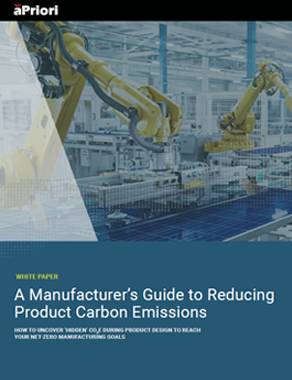How to Prepare for SEC Climate Disclosure Mandates
Many manufacturers struggle to understand where to start and how to implement sustainability changes to satisfy climate-related disclosure requirements from the SEC, EU, and other government/financial regulators. aPriori outlines how manufacturers can apply sustainability modeling to optimize products for cost, carbon footprint, and performance.
The US Securities and Exchange Commission (SEC) is the latest regulatory organization to propose new mandatory corporate reporting for climate-related risks. Specifically, the SEC climate disclosure plan would require some publicly traded American companies to report their upstream or downstream emissions if their carbon footprint is material to investors.
While the SEC is finalizing its environmental reporting mandates, the European Union (EU) and other policymakers already have environmental, societal, and governance (ESG) disclosure requirements in place. For large, publicly traded companies, the question is when – not if – they will be required to provide environmental disclosure.
Companies that incorporate sustainability into their overall business goals are well-positioned to streamline operations and capitalize on “green growth” opportunities compared to organizations that treat sustainability as an added business cost and an isolated operation. Successful companies are applying manufacturing insights to reduce their carbon dioxide equivalent (CO2e) emissions and meet their other business goals.
Global Sustainability Reporting
Seventy-five percent of the G20 nations have instituted some mandatory corporate reporting for climate-related risks and opportunities. Notably, the European Green Deal is targeting net-zero greenhouse gas (GHG) emissions by 2050. To help reach this milestone, the EU taxonomy provides a sustainability reporting and evaluation framework to help drive economic business activities that contribute to meeting the EU’s environmental objectives.
Public companies that meet EU disclosure thresholds are required to institute internal controls to identify and report on climate-related risks that may have a material impact. The companies are also mandated to provide their carbon footprint and plans to support the EU’s GHG reduction efforts in their financial statements.
Financial institutions, investors, and potential partners also use this sustainability reporting framework to standardize data collection across companies and make investment decisions. (Read more about EU stainability reporting requirements for manufacturers.)
Proposed SEC ESG Emissions Rules
In March, the SEC supported a mandatory climate risk disclosure proposal requiring companies to report on environmental-related activities that are “reasonably likely to impact their business.” Each registrant company would use the GHG Protocol as the standard to disclose its CO2e emissions. The GHG Protocol provides transparency and consistency for reporting assumptions and methodologies. Investors can use GHG Protocol data to compare standardized sustainability data among companies.
In October, the SEC reopened public comment for 14 days because some responses to the proposed rule may have been lost due to a technical error. The agency expects to provide final rules for its ESG reporting by the end of the year. The SEC will potentially expand its reporting standards to include a new Form 10-K sustainability section.
The SEC’s plan begins in 2023 (for 2024 filings) when companies will start reporting on their direct GHG emissions from owned or controlled sources (Scope 1) and indirect emissions from purchased energy generated (Scope 2).
Under the proposed rule, companies may also have to disclose elements of indirect GHG emissions reporting from upstream and downstream activities (Scope 3) if they are material. Initially, Scope 3 reporting may include a safe harbor period to protect companies from legal liabilities. And companies may not be subject to third-party verification during a phase-in period.
Registrants, however, will likely continue showcasing their steps to address climate change in annual reports and other investor communications.
Expand to Track Corporate SEC ESG Commitments
The SEC rule would require companies with a net-zero or related GHG reduction target to show how they intend to meet specific goals. This includes releasing a 10-K that details whether a company is making progress toward meeting its target and measuring progress in particular areas.
Manufacturers, for example, will need to report how they are reducing their GHG emissions or how they plan to. CO2e mitigation methods can include using alternative materials or production methods during manufacturing, purchasing carbon credits, or generating renewable energy certificates [RECs].
Companies that rely on purchasing carbon credits could face additional financial exposure because the cost of carbon offset credits is projected to increase exponentially, according to Bloomberg and other analysts.
The SEC’s additional sustainability reporting also strengthens earlier efforts to enforce transparency requirements for ESG investing. This includes issuing penalties for “greenwashing,” which refers to companies that make false or misleading claims about the scope or impact of their environmental efforts.
How Should You Start Your Sustainability Program?
Manufacturers are adopting the Greenhouse Gas Protocol’s levels – Scope 1, 2, and 3 to measure CO2e throughout the supply chain. Once there is a baseline for a product’s current carbon footprint, cross-functional product design and manufacturing teams can analyze tradeoffs among cost, sustainability, and design for manufacturing (DFM), and make decisions accordingly.
Product brands are using aPriori’s Manufacturing Insights Platform to incorporate sustainability insights into their strategic planning and manufacturing operations. With a unified view of the product development and manufacturing process, businesses can understand a product’s CO2e impact during early design phases, and then evaluate opportunities to reduce a product’s carbon footprint. Product design and production teams can simulate design alternatives using different materials and manufacturing processes to meet CO2e emissions, cost, and performance targets.
Manufacturers with the insights to evaluate cost, carbon footprint, and manufacturability are well-positioned to use sustainability as a competitive advantage.
Get aPriori's Exclusive Guide to Reducing Product Emissions









